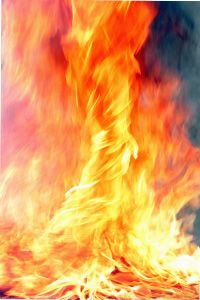Vertical Vortex: Fire Tornadoes and Updrafts
Tornadoes, spouts and whirlwinds have something in common: They all serve as examples of atmospheric vortices -- air masses that spin about either a horizontal or vertical axis. Vortices can range in size from small eddies that swirl around the lee side of buildings to huge mesocyclones that churn in the gut of a thunderstorm. Large or small, most atmospheric vortices begin when air near the planet's surface is heated, either by the sun or by a fire on the ground.
Let's consider a vortex created on a hot day over dry terrain. In this situation, air near the ground absorbs more of the sun's energy and heats up faster than air higher in the atmosphere. As the temperature of the ground-level air rises, it becomes less dense and more buoyant. This superheated air then rises in columns or chimneys, creating strong updrafts that can extend thousands of feet into the air. In most cases, an upward-spiraling motion -- analogous to the whirlpool effect you observe when water drains from your bathtub -- develops within the column of air. Some of these vortices are weak and remain invisible. Others, spawned from intense updrafts, generate significant rotation as even more air is sucked into the spinning column. When they pick up dust or sand, they become clearly visible as whirlwinds.
Advertisement
Now imagine a different scenario: a wildfire burning out of control over several hundred acres of brush or timber. In this situation, it's the fire, not the sun, that increases the heat of the air near the Earth's surface. The results, however, are the same. Superheated air above the blaze rises rapidly in columns or, to use firefighter speak, in plumes. As the air rises, it begins to rotate, drawing in more air and slowly drawing the flames upward in a tight spiral. Most fire whirls stay small -- a foot or two in diameter. But some can grow to be 400 feet (122 meters) tall and 50 feet (15 meters) wide. In other words, they can assume proportions of a small tornado.
Notice that the axis of rotation in the examples above lies perpendicular to the ground. This is often the case, especially if extreme heating causes intense updrafts. But not every vortex begins its life standing straight up. Some begin on their backs (or bellies, if you prefer), with the axis of rotation oriented parallel to the ground. Then, an uplifting force tilts the horizontal vortex up until it stands on one end. Scientists now believe that this is how many fire whirls form. They also think the same processes explain how the vortex at the heart of a supercell tornado -- the mesocyclone -- develops and evolves. Up next, we'll look more closely at this peculiar aspect of vorticity and what conditions can create the perfect firestorm.
